How to Prepare Statement of Cash Flows in 7 Steps
How many times did you sit with the head in your hands worrying about the statement of cash flows? Lots of work, preparation, calculations, adjustments…. and damn it, figures just do not add up! It’s very frustrating and creates headaches. I’ve been there.
You might find making cash flow statements one of the most challenging issues no matter whether you use US GAAP (if you’re in the USA) or IFRS (if you are in one of more than 120 countries in the world applying IFRS). Many people also struggle with preparing IFRS statement cash flows because…
- It’s the only statement prepared on a cash basis, not on an accrual basis;
- Accounting records must be adjusted to exclude non-cash items which might be quite demanding.
Maybe it looks very complicated, but don’t worry, people make much more serious IFRS mistakes than cash flow statements! If you subscribe to my e-mail updates you’ll get my free report “Top 7 IFRS mistakes” and you’ll learn how to avoid these mistakes, too.
But let’s be clear in one point: You still need a good method and resources to prepare statement of cash flows in line with IAS 7. I personally hated to prepare cash flows until I learned this simple method that I am going to show you.
UPDATE 2018:This article has already got a lot of attention and I’m grateful for this. Therefore, I published a video with step-by-step illustration of making cash flow statements. This video comes from my IFRS Kit, but if you’d like to watch it for free, please subscribe to my newsletter (by entering your e-mail address to the form on the right sidebar) and you’ll get it within my free IFRS mini-course. Enjoy!
Before Start
This method works only if you understand the following matters:
-
- You already know what the statement of cash flow is and what parts it has (operating, investing, financing and final reconciliation). You understand the basics of cash flows, relationship between individual components of financial statements (balance sheet, income statement and others), accounting etc. If that’s not the case, I sincerely recommend watching our online videos on these topics—in particular IAS 1: Presentation of Financial Statements and IAS 7: Statement of Cash Flows.
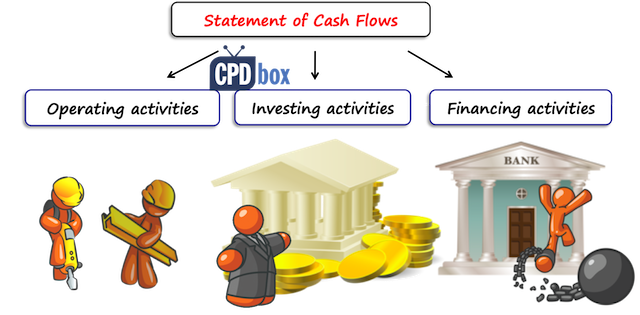
- Availability of various accounting information is generally good and you can easily access them. Sometimes you will need to do some adjustments resulting from supporting data and it would be lovely if you could get all pieces of info in the blink of an eye.
- You will stay cool, no nerves, no stress, just patience and concentration on this lovely work.
Ready? So let’s start. We are going to learn how to prepare statement of cash flows by indirect method.
Step 1: Prepare—Gather Basic Documents and Data
In order to start, you shall obtain at least the following documents:
- balance sheet (statement of financial position) as at the end of the current reporting period (closing B/S) and as at the beginning of the current reporting period (opening B/S)
- statement of comprehensive income (profit or loss statement + statement of other comprehensive income if applicable) for the current reporting period
- statement of changes in equity for the current reporting period
- statement of cash flows for the previous reporting period—well, you can proceed further without this, but it’s good source of potential recurring adjustments in the current period
- information about material transactions in your company during the current reporting period. Of course, you can adjust your statement of cash flows also for immaterial items, but it would not significantly change the information value of cash flow statement (since it’s immaterial, but careful about aggregation), so I would not bother about it
The first four bullets are crystal clear, but what sources of information about material transactions to use? Here is the short list of my ideas what to look for:
- major contracts that your company entered into during and before the end of the reporting period (lease, rental, hedging, construction—all sorts of)
- minutes or memoranda from the meetings of managing bodies in your company, like board of directors’ meetings, supervisory board meetings, shareholders’ meetings, audit committee meetings, etc.
- files from your legal department related to any proceedings against your company (and the opposite cases, too)
- documents from your investment/long-term assets department to look for major purchases, sales, exchanges and other transactions with fixed assets
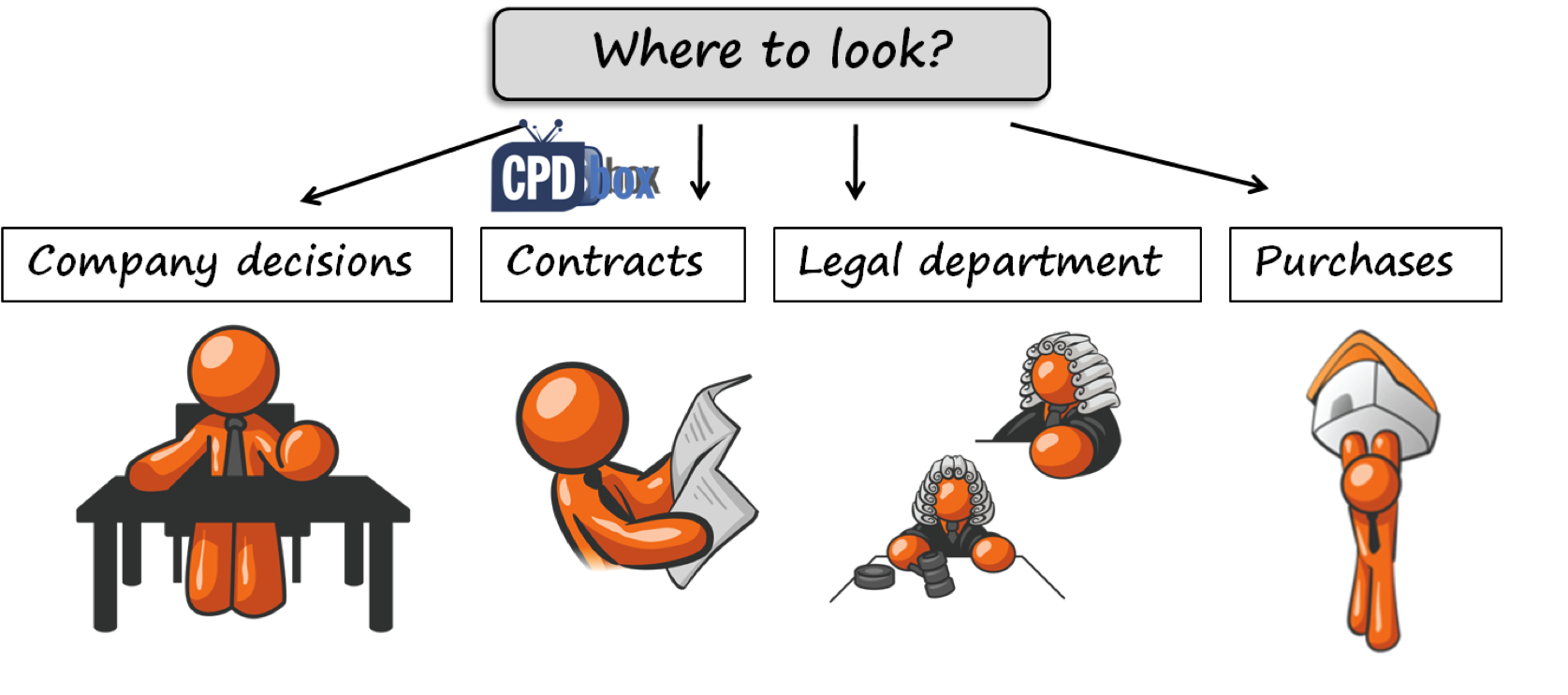
That’s just a general shortlist and I am sure you know better what kind of transactions might be significant in your company—so go, ask and look for where you think it’s appropriate.
Step 2: Calculate Changes in the Balance Sheet
Now, take the closing and opening B/S and make a simple table with 3 columns: the first column – title of caption in B/S (for example, tangible non-current assets), the second column—balance of this caption from the closing B/S and the third column—balance of this caption from the opening B/S.
As you sure know, each B/S has 2 parts – assets and equity & liabilities. Ideally, totals of both parts should be the same, right? So when you do this simple table, please, enter assets with “+” sign and equity & liabilities with “-“ sign. Now do the check – if you entered the signs and numbers correctly, total of all assets and equity & liabilities should be 0 (don’t include subtotals).
In the 4th column, calculate changes in the balance sheet over the current period. Use simple formula: opening B/S minus closing B/S (careful, not the vice versa!). When you calculate all the changes correctly, total of all changes will be 0 (again, don’t include subtotals). Just let me add that you can use your general ledger accounts instead of balance sheets and you will get greater details as balance sheet represent aggregated figures. It really depends on the level of details you need.
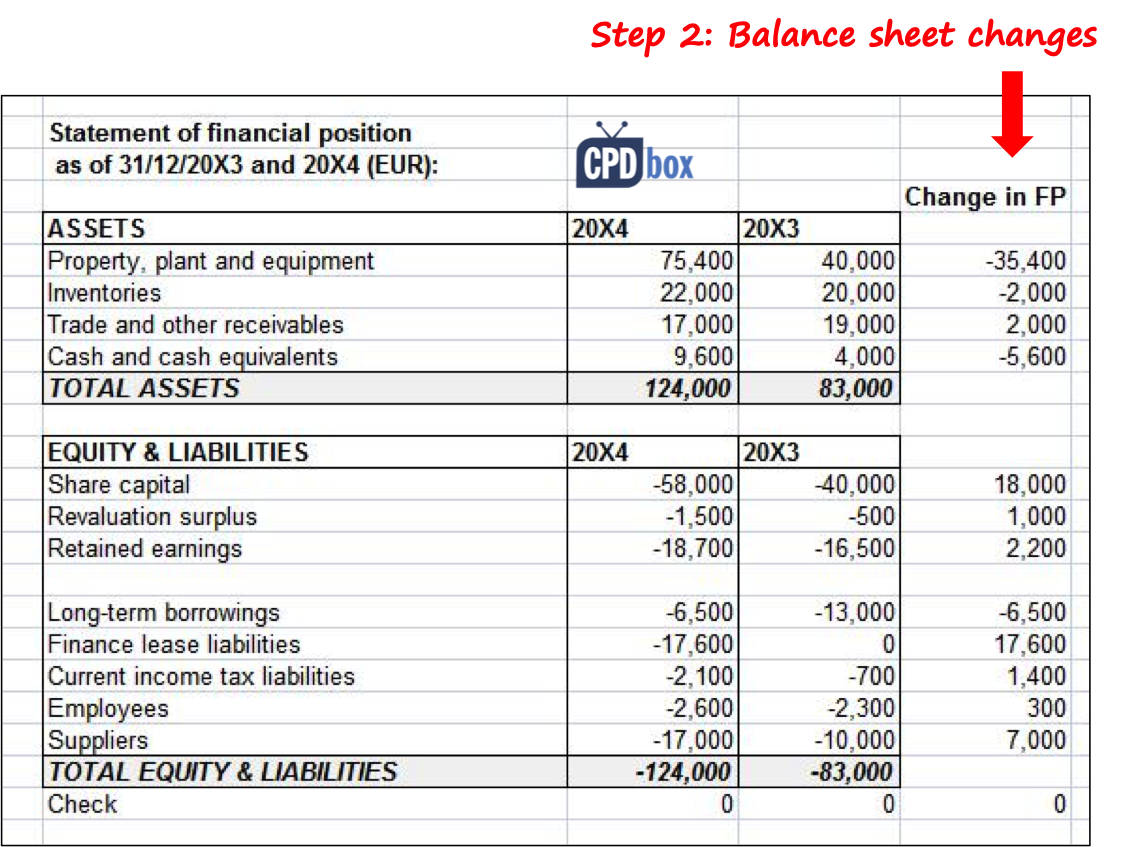
That was an easy bit, agree? But it’s very important to do it properly and not mix the signs and formulas. So you better check it again before moving further.
Step 3: Put Each Change in B/S to the Statement of Cash Flows
By now, you should have a blank statement of cash flows ready for further work. Ideally, you can use the statement of cash flows from previous period and take only titles of individual captions. Likely you will have the same items also in the current period cash flows. Anyway, you can always insert a line for some new items if necessary.
The rationale behind this step is that each change in the balance sheet has also some impact on the cash flow statement—and if not (when movement in balance sheet is fully a non-cash item), it will be adjusted for later.
So now you should look to all changes in your balance sheet and enter each number to the blank form of cash flow statement. For example, you have calculated that change in your property, plant and equipment is -10 000, so you enter this figure in the investing part of your blank cash flows under the title “purchases of PPE” (as a change was minus 10 000, it means that the company spent the cash to purchase PPE).
You shall continue assigning each change in the balance sheet to the statement of cash flows until you finish all. When you are done, you should have a statement of cash flows with 2 columns—1st column = titles of individual cash flow captions and 2nd column = changes in the balance sheet assigned. Now perform a check—total of the 2nd column shall be 0 (without subtotals). If it’s not, you have done something wrong, so go back and review.
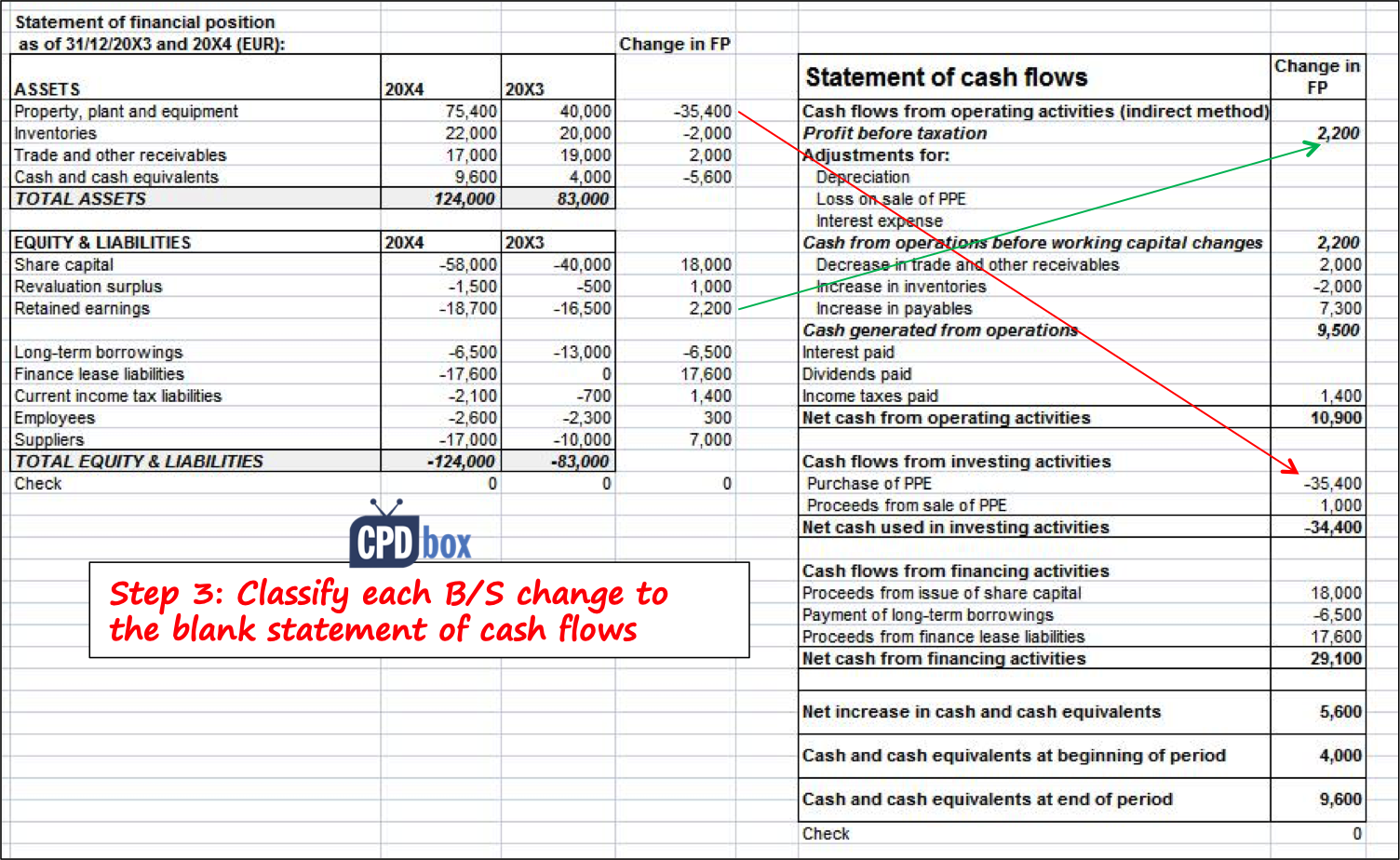
Well, if you’d like to know precisely where to put individual changes and how it looks like, please watch our video IAS 7: Statement of Cash Flows—each step is explained very clearly in detail in Excel file with all numbers included.
Step 4: Make Adjustments for Non-cash Items from Statement of Total Comprehensive Income
By now, you have a solid base to finish your cash flows successfully. However, these figures do not mean anything. We have more work to do.
Take the profit or loss statement and statement of other comprehensive income. Then identify any numbers where non-cash transaction might have been recorded. Typical non-cash adjustments are usually as follows:
- depreciation expense
- interest income and expense
- income tax expense
- expense for recognition or income from derecognition of various provisions
- change in revaluation reserves
- foreign exchange differences at the end of period
- revaluation of certain assets and liabilities at the end of period
- barter transactions
and many more.
So once you identify non-cash transaction, just make adjustment in the blank statement of cash flows. Do each adjustment in the separate column. Making adjustments means simply adding one number to one caption and deducting it from the other one. It’s like doing double bookkeeping. The trick is to identify: 1) which captions in cash flows are impacted by non-cash item and 2) where is the plus side and where is the minus side.
For example, let’s take depreciation expense. On one side, it causes non-cash decrease in profit figure, so it should be added back. Just enter the figure in the operating part under the heading “adjustments for non-cash items: depreciation” with a plus sign. And where do we put the same figure with a minus sign? Well, depreciation artificially increased total payments for purchases of PPE. So we just deduct it from the investing part under the heading “purchases of PPE”. Perform a check—total of adjustment shall be 0.
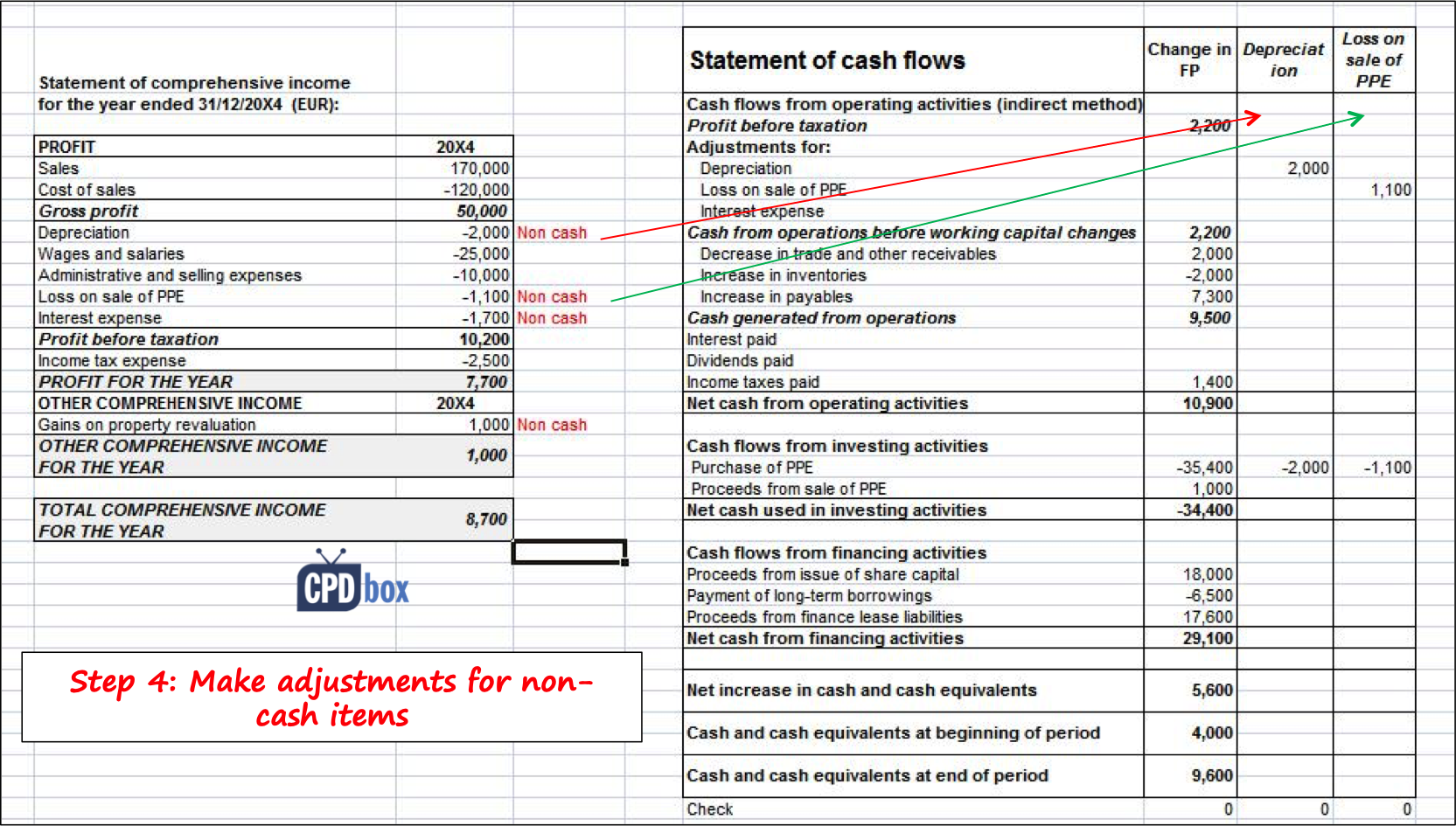
Go on until you are done with all identified non-cash adjustments from statement of total comprehensive income. And remember to verify your totals after each adjustment.
Now I know this is probably the most difficult part, because sometimes it’s hard to identify where to put the change and which sign to use. But the principle is always to do both sides of adjustment and keep your totals to be 0.
Again, let me remind you that our comprehensive step-by-step example included in IAS 7: Statement of Cash Flows video shows various types of non-cash adjustments and explains how to deal with them.
Step 5: Make Adjustments for Non-cash Items from Other Information
Step 5 is pretty much the same as step 4, but now you shall look to other information sources. I listed several of them in step 1.
So for example, you find out that your company entered into new material lease contract. And there is a non-cash adjustment hidden for sure, because on one side, increase in PPE was recorded that was not purchased for cash. On the other hand, increase in loans or lease liabilities was recorded, but the company have not received any cash. So you shall adjust for it, exactly the same way as described in the step 4. Remember about your total—it should be always 0.
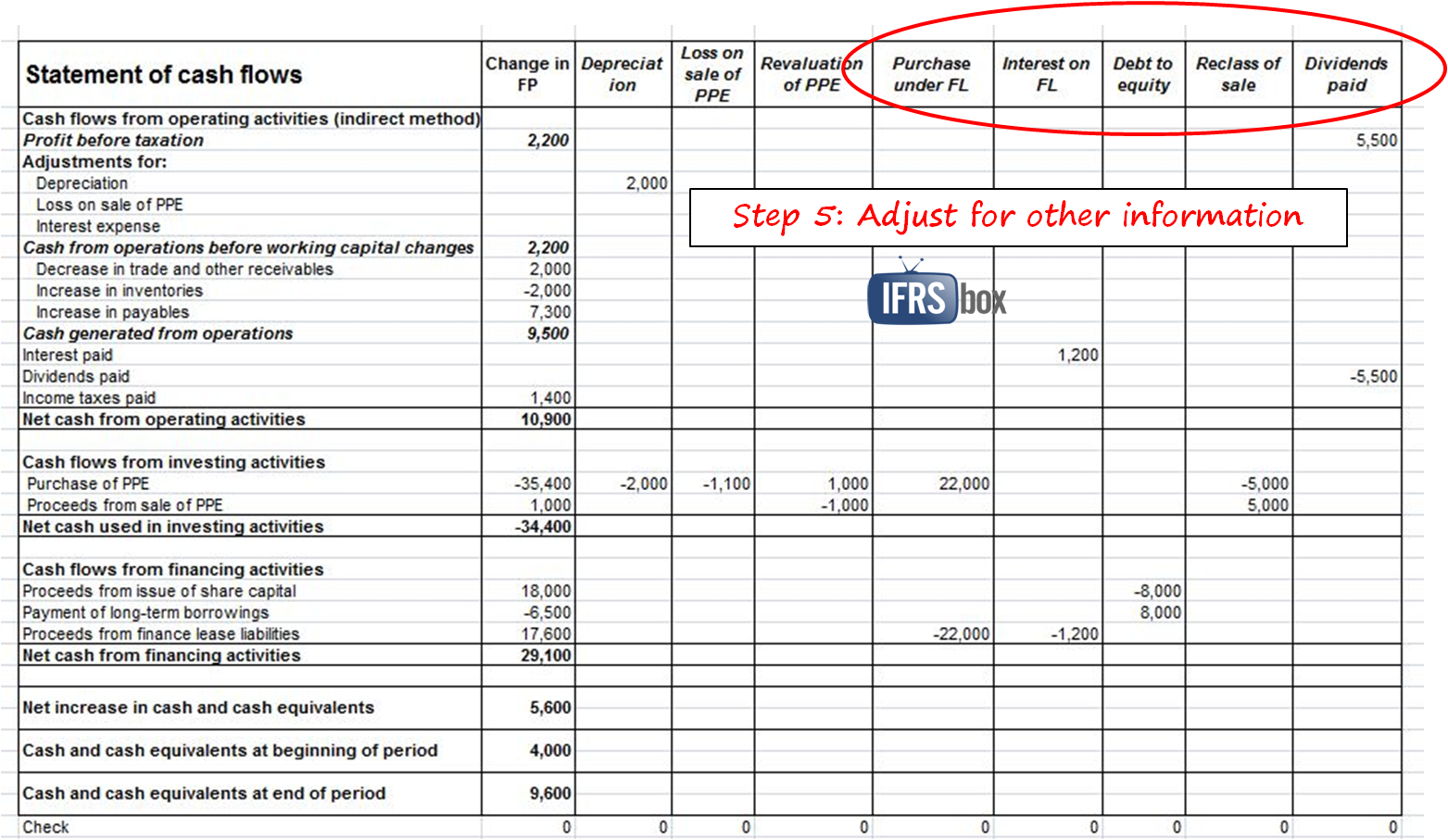
You can continue this way until you review all information you consider relevant or necessary. I just remind to make each adjustment in the separate column and check your totals to be 0.
Step 6: Prepare Movements in Material Balance Sheet Items to Verify Completeness
Well, this step is really for diligent, hardworking and dutiful people. You can skip it if you want, but I recommend doing it from very obvious reasons: you will be pretty much sure that you have made all material non-cash adjustments in your cash flows without omitting something important. Well, if you are sure that you have all available information from various departments in your company to include, than fine. But if you are unsure about it, then rather do this step.
It’s very easy. Just take the biggest or material items in your balance sheet and reconcile their movements between opening and closing balance. Check whether each movement is taken into account for in your cash flow statement so far.
For example, PPE. You might find out that movement of PPE was as follows: closing balance (from closing B/S) = opening balance of PPE (from opening B/S) plus cash purchases of PPE plus lease acquisitions of PPE plus PPE received as a gift minus depreciation of PPE minus loss on sale of PPE minus cash sale of PPE. Which items from this movement are non-cash? I suggest the following ones: lease acquisitions of PPE, PPE received as a gift, depreciation and loss on sale of PPE. So for each of those non-cash items, you should have made an adjustment. Have you? Fine. Have you not? Well, that’s why you do the movements—you identified another necessary adjustment, so make it.
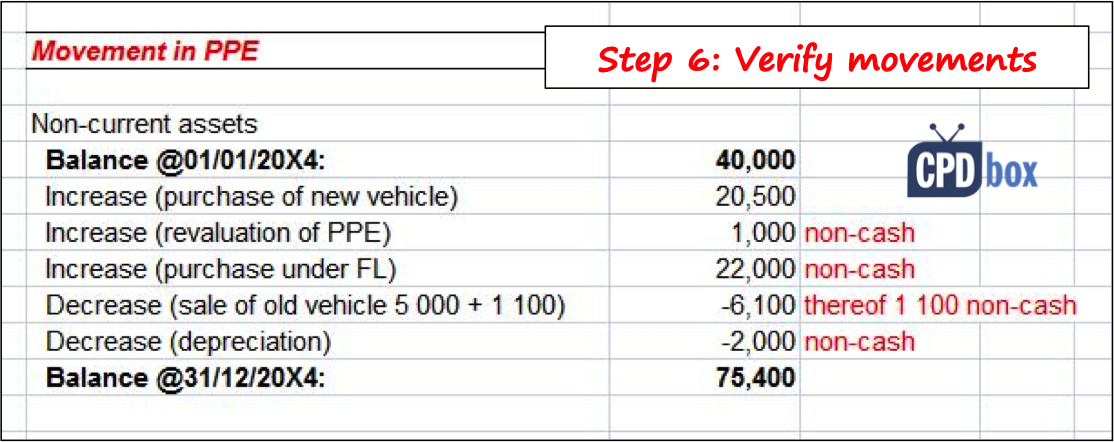
Step 7: Add Up and Perform Final Check
Let’s assume that by now you have done a lot of work, made a lot of adjustments, verified movements in material B/S items, your totals are always 0. Great job!
In this stage, finishing your cash flows is a piece of cake. What do you have in front of you? Huge excel file with 1st column being the headings and titles of your statement of cash flows, 2nd column being the changes in balance sheet and 3rd–xth columns being individual adjustments.
Now it’s time to draw the last column. And you guessed it—your last column will be the statement of cash flows itself. In the individual lines or items from statement of cash flows, you shall make “horizontal” or “line” totals, or in other words, sum up the numbers from columns 2 to x. You effectively calculate the change in the balance sheet for the individual caption adjusted by non-cash items, that gives you the appropriate cash movement for that caption.
Fine. Then verify if it makes sense. For example, you will get certain number in the line “purchases of PPE”—go and verify this number with your accounting records, or ask your investment department whether cash payments for PPE during the period were as you calculated. If not even close to that—you must have omitted something, or messed up signs or you made some other mistake.
Finally, look to “vertical” total of the last column—if it’s 0, you are the winner and deserve to sit back, close your eyes, relax…. but that’s topic for another article :-).
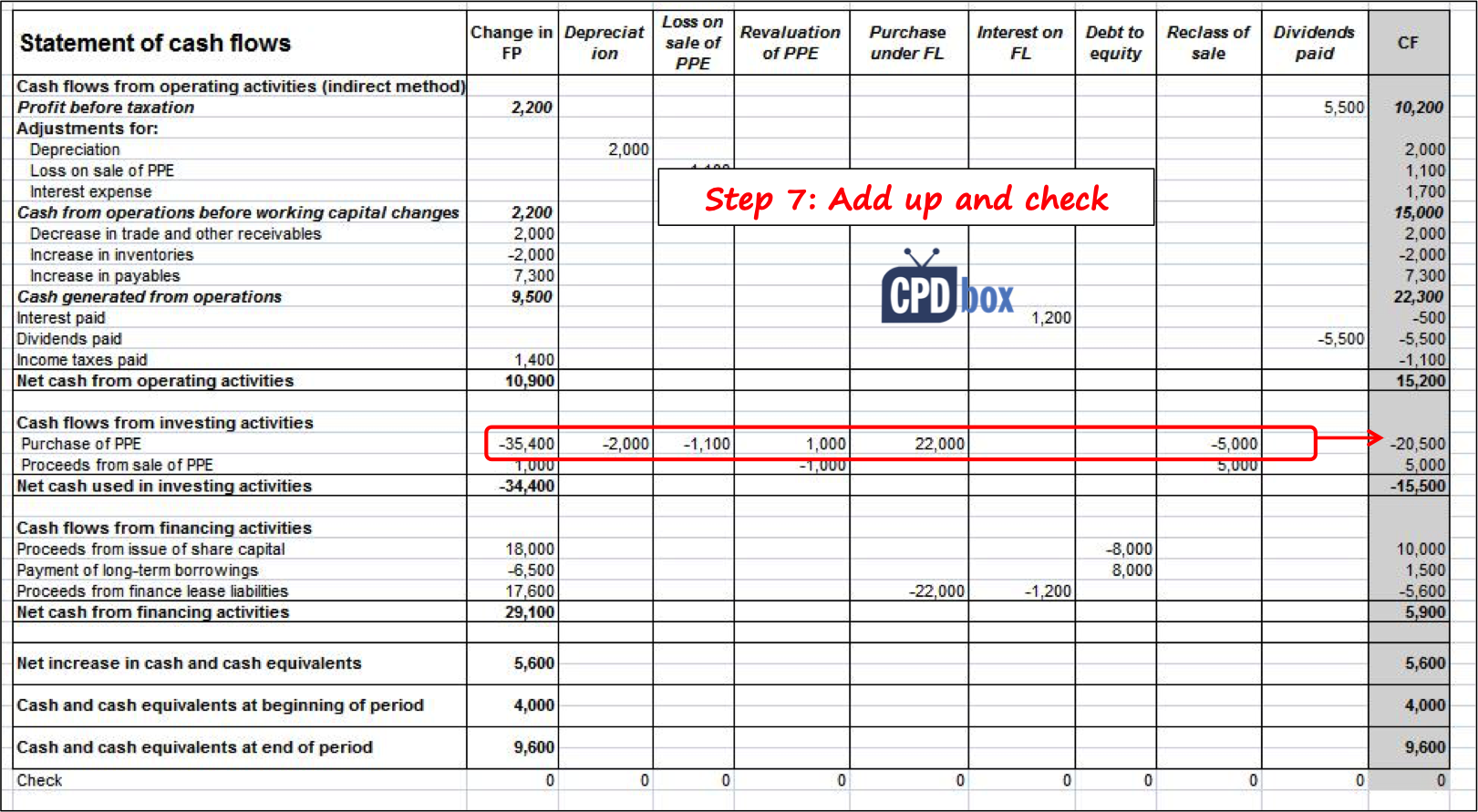
A Few Final Words…
Please bear in mind that my goal of this article was to draft a systematic approach for preparing a statement of cash flows rather than to explain the details of individual adjustments or other technical and factual issues. I just wanted to prove that it’s doable once you do it step by step.
You can see the video with this process here:
If you find it too difficult, or you do not understand all adjustments fully, or you need a clear demonstration, than I frankly encourage you to subscribe for our IAS 7: Statement of Cash Flows video course. You will not only learn about basics related to statement of cash flows, but also all above process is demonstrated very clearly in a comprehensive example and the most common cash flow adjustments are discussed.
Tags In
JOIN OUR FREE NEWSLETTER AND GET
report "Top 7 IFRS Mistakes" + free IFRS mini-course
Please check your inbox to confirm your subscription.
Recent Comments
- Albert on Accounting for gain or loss on sale of shares classified at FVOCI
- Chris Kechagias on IFRS S1: What, How, Where, How much it costs
- atik on How to calculate deferred tax with step-by-step example (IAS 12)
- Stan on IFRS 9 Hedge accounting example: why and how to do it
- BSA on Change in the reporting period and comparatives
Categories
- Accounting Policies and Estimates (14)
- Consolidation and Groups (25)
- Current Assets (21)
- Financial Instruments (56)
- Financial Statements (54)
- Foreign Currency (9)
- IFRS Videos (74)
- Insurance (3)
- Most popular (7)
- Non-current Assets (56)
- Other Topics (15)
- Provisions and Other Liabilities (46)
- Revenue Recognition (27)
- Uncategorized (1)

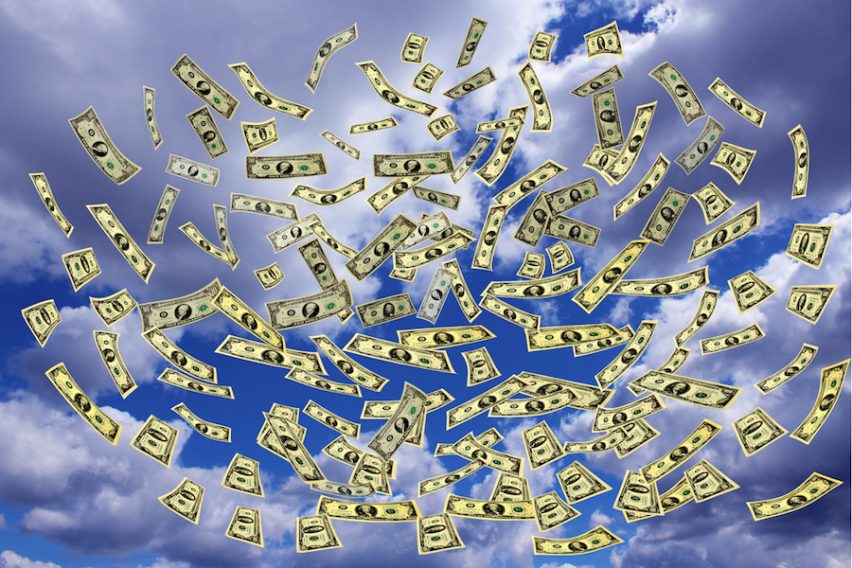



Dear Silva, All your explanations and post have been very insightful. Also, I am planning to save to buy your IFRS kits soon. Please i. how do you treat the double entries of impairment of trade receivables in your cash flow statement. 2. How do you treat increase in investment property in cash flow. Grateful to receive your response on this. Thanks,
Hi Olaide,
thank you! To your questions:
1) As non-cash item, so you add the charge in P/L back to the profit before tax and deduct the same amount from the line change in receivables, all in the operating part
2) If you purchased it, then it would be the cash outflow in the investing activities. S.
Madam,
Your articlewas very useful to me. Thank you.
May I raise a fundamental issue wrt company financial statements?
In the vertical type of B/S some companies show Assets at the top and Equities and Liabs at the bottom
Whereas, certain other companies show Equities and Liabs at the top and Assets at the bottom.
Why is this difference in presentaton? Please could you educate me in this regard
H S Shridhar
Bangalore 22-03-2022
Hi Silvia, great work! Thank you for providing this example. Two elements are not clear form me, therefore I would like to ask you:
a) Row “Interest paid”. The only one column which impacts it is “Interest under FL” = 1200), but at the end we see that interest paid equals -500. My guess is that you also incorporated “interest expense” = 1700, So the equation for interest paid is: -500 = 1200 -1700. Is my understanding correct?
b) Why you moved “Interest under FL” (=1200) from “Interest paid” to “proceeds from financial lease liability” ? Is it related to some old regulations (other than IFRS 16)? I am asking, because in your other article leasing impact is handled completely different https://www.cpdbox.com/how-to-present-leases-ifrs-16-in-the-statement-of-cash-flows-ias-7/
Thank you Silvia much respect
CPA:Edwin Michael
Thank you!
How does write-off (example, stock destroyed or no longer saleable) of inventory affect cash flow statements?
It is treated in operating part as a non-cash item (added back in profit or loss).
Thank you Silvia for the good write up on IAS 7 Statement of cash flow. You have really helped me enough. I will appreciate much if demonstrate how consolidated statement of cash flow is prepared. God bless you.
Paul from TANZANIA
Thank you 🙂
sir please provide problem and solution with examples, How to prepare cash flow as per company norms
Hi Sylvia,
There is also one missing point by getting the figure of profit before tax. You should add back income tax expense to retained earnings to get the figure of 10,200 (2200+5500+2500)
Hope it is just a technical issue.
Regards,
Mushvig
Yes, you are right, it is missing on the pictures because it was too wide, but the final CF takes that into account. As I have mentioned above, not all adjustments are show in the pics. Thanks.
Hi Sylvia,
Thanks for such a great work U have done.
However, I have a question related to the non-cash transaction adjustment which is about increase in PPE resulting from finance lease. Why your figure is 22,000? Where did U get this figure? Is it just a coincidence? If we increased PPE by 22,000 as a result of finance lease, why there is not such an increase in the lease liabilities? There is just an increase of 17,600 in lease liability which means we can just increase our PPE by this amount/
Thanks for your clarification in advance!
Hi again, Mushvig, I do believe that the final picture in the article explains this. Lease liabilities are affected not only by taking new liabilities of 22 000, but also by the repayments of liabilities brought forward from previous period.
Thank U very much, it was a clear article in simple words.
Hi Sylvia, 1. what of other line items of the cash flow statement such as proceeds from loan and repayments which need to be separated. Using this approach is there a certain way of separating these using you approach. 2. How can one utilise your approach in preparing a cash flow statement under IAS29.
Profit is accumulated in retained earnings. And from the illustration its clear that profit was used in the cash flow statement. Furthermore if you go down with the illustration it clearly shows that if you have other items affecting retained earnings movement like dividends you also need to adjust them. Check how the 5,500 for dividends was adjusted.
Hi Mike, this is the illustration of the basics. If you have other items, then of course you need to add line items. And yes, you can use this approach when preparing CF in hyperinflationary economy – you just need to think of restating the amounts to the current prices.
Hi Silvia,1.can you use this approach when preparing cash flow statement
Using direct method?
2.To which change are the Deferred tax and accumulated depreciation balances changea allocated to when in step 3?
Hi Njabulo, did you find an answer to that? it also bothers me 🙁
Thanks!
why is that when you add all the items for profit before taxation, it is equal to 7,700 (5500+2200), not 10,200?
Hi Sylvia, thank you so much for this!
Can you please help out with the new IFRS 16 disclosure?
Step 2 – My movement in SFP shows RoU asset carrying amount of -10k
Step 3 – I add amortisation from the SOCI to RoU asset and it now totals -15k (At acquisition RoU).
Step 4 – How do I cancel out RoU asset since it is a noncash item?
Similarly, the SFP now shows a lease liability of 18k. But the actual cash flow needs to be the payments made of -12k?
Hope you can assist. Thank you!
Hi Teresa, you should think of how ROU appeared in your SFP in the first place and then reverse it. I guess your lease liability was also non-cash item, isn’t it? I don’t know the precise numbers, but to give a hint: You should cancel amortization of ROU (non-cash item in operating part) with the change in ROU asset – you did that correctly. Then you also should cancel initial lease liability with ROU asset as both of them were non-cash (I assume your journal entry was Debit ROU/Credit LL, so reverse it in your CF statement). And then if the resulting cash out is not what you expect to see, then there must be something else to adjust, too. I hope it helps! S.
Awesome! what a helping hand during this critical time of my preparation for an examination. Thank you so much, Silvia, the article is a very helpful one.
How would you show on the face of the Cashflow the following scenario. Shareholder loan adjusted to Share premium account.
This a good article. with very clear and articulate steps. Thank you for sharing your professional knowledge
Hi Silvia,
How you get the amount of 8,000 in debt to equity? Thank you for your response.
Hi Maryam, when you asked that question, I realized I never put an actual question to this example, my mistake. I will correct that. The amount of 8 000 related to conversion of debt to equity which is a non-cash item, hence the adjustment. S.
Unbelievable.. What an explanation.. Its an old post which i managed to get on google search and today it helped me to get my cash flow done within minutes. Thanks a lot for this post.
Thanks a lot Silvia
i appreciate your work. Really good effort. Whenever i stuck in cash flow i come back to this methos and read this article again and again.
Thanks & Best Regards
Arslan Ahmed
from Pakistan
Hi Ms Silvia! Thank you so much for this awesome job I do appreciate it. I still confusing on final work precisely dividends paid 5500 and its sum amount 10200. Would you please explain how did you calculate this amount cuz I tried but it gave me wrong.
Again I can’t thank you enough for this such great article.
Sincerely,
Tom
Hi Slivia,
when an untraceable material prior period errors were adjusted to retained earnings for the current period for the purpose of balancing all line items effected by accounting errors. if will are to go by using our traditional method of preparing cash flow the cash flow will not balance with that changes on the retained earning as a result of the adjusted error. Looking at the figures on your unbalance closing cash and cash equivalent you will notice the difference is actually that changes in retained earning. now you need to bring those changes to your cash flow statement for your CFS to balance. where will you position the changes on your CFS and which line item will it represent. i mean what will you name that very line item.
Thanks
How do you capture IFRS 6_Leases in cashflow statement?
Thank you guys! I was having trouble tallying my cash flow statement and could do it with the help of this article! The MD is really impressed with my work!
Kudos!
Can you help me to solve a question on cash flow statement. i can send you the questions
Hi Rahul,
I do respond to these public questions here, but I cannot solve on demand questions sent via email. If you need urgent help, we offer tailored service here: https://www.cpdbox.com/my-helpline/
All the best
Silvia
Hi, I’m wondering where to put the impat of change in long-term trade receivables (it’s not working capital, since long-term, is it?). What about deferred tax receivables and payebles from the balance sheet?
Thank you
Hi Emma, did you find an answer to that? it also bothers me 🙁
Thanks!
lot of thanks from my core of heart, i learnt in university but forgot it, i understand very quickly the way you explain must appreciated .
Looks realy great! Thanks for the post.
Hi Silvia Thanks for the information.
My question is what is the effect of write offs on cash flow statement, if we add back write offs as a non cash item to net income it will result in a cash increase, AND write offs also result in the reduction of receivables as well, in cash flow statement reduction in receivables are interpreted as cash inflow.
So in both of the above cases the write offs are actually resulting in a cash inflow, However, logically write offs should have no impact on cash flow statement or either result in cash outflow not inflow.
Kindly tell us about the correct treatment of write offs in cash flow statement.
I am appreciative of your efforts to make us understand IFRS. Thanks!
one remark: in step 3 (the green arrow)
You link the profit before taxation to the retained earnings movement. However the retained earnings movement is after tax, so this can not be the same
Please follow the next steps and you’ll see why I did so. It is all correct.
Thank you for your HELP
Just when I thought i had forgotten how to prepare cash flow statement, voila your page bounced me back. Thanks a lot for the well detailed and explanatory write up…Thumbs up.
Thanks for information and guidelines
Great work Silvia !! Thank you for sharing ! However I have a question. How to do you deal with non-cash changes in FP (e.g. an increase in provisions for employee benefits) ? If you don’t take into account the above change in FP, the check formula will result in an error. How do you handle it ?
need help with cash flows statements
Really very nice practically we learn cash flow statement here i learn very easily and Dear Sir blance sheet changes explain very nicely which is very easy way to learn thanks a lot we are appreciate and says thanks to your goodself.
Thank you Silvia M for sharing good Article
Keep sharing
Thank you for sharing .
i have question related to non-cash expense
When we have to add back the interest expense , then which item will be affected ?
Wow this is excellent, wish I was good at accounting as you. Would love to further my career and obtain my hands on the IFRS Kit but alas, my employer will not pay for it:(…could actually go towards my CPD:) (not sure why they don’t see it as a benefit, maybe because I could end up better than them:)….
Dear Amy,
thank you for your kind words! Now let me tell you that if you are very serious about your development, you should start thinking how to pay for your education yourself without relying on your employer. I don’t mean specifically my IFRS Kit, but any education you chose. If you can control the things, you will derive more benefits 🙂
Dear Silvia, great work
Thanks for sharing,
I will be sharing a tool which is newly developed ms excel tool and can perform various accounting functions.
Excel-Accounting-Budget-Analysis.com
It is free for Non profit organizations and universities.
My advice will be, It is best for startups, small business.
Thanks sylvia am still bit confused on treatment of barter transactions during cash flow preparation. The info is very helpful.
i need help on this exercise
2008 2009
FA 264 327
CA-Inventory 176 123
– Receivables 87 95
– Bank 0 29
Totals 557 639
Share capital 120 200
Revalution reserve 97 66
Share Premium 0 30
Retained earnings 41 71
10% Debentures 150 100
Payables 70 126
Bank 22 0
Tax 54 39
Interest Payable 3 7
Totals 557 639
(comment clipped)
prepare both direct and indirect methods cashflow statements
Seriously? 🙂 Please study and try it yourself 🙂
Thank you Madam for your assistance.
Thank you supporting me,about preparation of cashflow stmt.
Hi
I am doing an accountancy degree and I am on my 2nd year, just a quick question why are the balance sheet changes calculated that way to give a negative value. When the later year is an increase on the year before. I need to get good understanding of cash flows as my exam in January has a cash flow question which carries a lot of marks. I would welcome any books etc that can help with understanding cash flows, I do find your site great by the way.
Thanks
Dear Nigel,
good luck for your exam!
The balances are “negative”, because I wanted to show you how the cash could move (not the related asset). For example, PPE increased from 40 000 to 75 400, but it means that the company purchased PPE for 35 400 and the Company’s cash decreased by that amount. Of course, it’s not necessarily truth (as there’s depreciation etc), but it’s the first step and the adjustments are made later.
Simply speaking, the changes show the change in cash, not the change in the related item in the balance sheet.
Hope it helps!
S.
Thanks for your insight on IFRS. Please try to develop summary of IFRS 6.
Hi Silvia,
Thank you for the article. It seems even after several years, many people are still finding it valuable.
I was wondering if you could help me with a particular transaction. It is a real world transaction
Company A recently changed to the Revaluation Model. It is a development company with a large land bank. All plots have previously been revalued and as such the revaluation reserve surplus has a large balance that span all plots of land.
Company A then entered into a JV agreement with Company B where Company A contributes Land (one plot) and Company B contributes cash for the development.
This transaction was accounted for as a disposal in the relevant entity (which owns multiple plots of land). As an example, the historical cost is say 20m, the revaluation reserve is 15m and the total consideration of the disposal is therefore 35m but not as cash.
My thinking is that the disposal should be shown in CFI but as 35m. So too, the revaluation reserve surplus is reduced by the proportion related to that plot i.e. 15m as done in Step 7 of your article.
What’s your view? Thanks in advance
Will, if I understand it correctly, then Company A gained the investment in JV in return for the land. What were the journal entries in the books of A? I would say Debit Investment in JV/Credit Land with 35, and then Debit Reval. surplus/Credit Retained earnings 15 – is that right? (it should be 😉 )
In this case, this is pure non-cash transaction and therefore, you should eliminate both entries. In other words, you show 0 as acquisition of new investments, you show 0 as disposal of the land and you need to adjust the change in retained earnings by revaluation surplus (otherwise the difference does not give you the net profit). S.
this is direct method or indirect method?
Indirect.
I subscribe to your newsletter but I didn’t get the step by step video!!
why is that?
Dear Khalid,
after subscribing to my newsletter, you will receive a number of educative e-mails, but not all of them come in 1 day, so please be patient and you’ll get it. Thank you for subscribing! S.
Dear Slyvia,
1.In respect of consolidated cash flow
iro of foreign subsidiaries please advise the rate to be used for each time is average rate during the year and the cash balance is translated using closing year end balance hence difference is translation balance
2, what is the implication if no intra balances is adjusted
3, iro purchase of equipment you mentioned in your article to check with dept and equipment paid by cash only
if equipment purchased on credit is included the effect will be an increase in sundry creditors which has a upward effect on cash flow balance , please can you elaborate on the rationale of only cash purchase of PPE
Regards
Mohammad
Hi Mohammad,
1. You should NOT translate your subsidiary’s statement of FP to a foreign currency and then make a cash flow statement. Not at all. You should firstly make up a cash flow statement in the local currency and only then translate it to a presentation currency. Once you have this cash flow statement in the local currency, use the average rate (the same as with P/L statement).
2. Then your numbers will be overstated.
3. Not sure I got this question correctly, but if you purchase your PPE with cash, then you do not adjust anything. Simply make up a difference and done.
S.